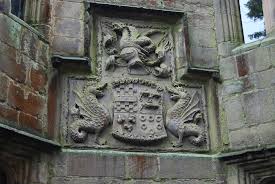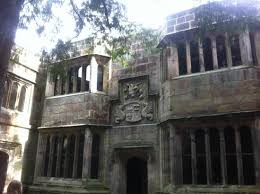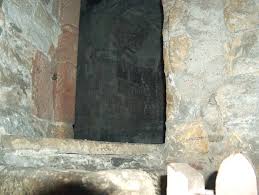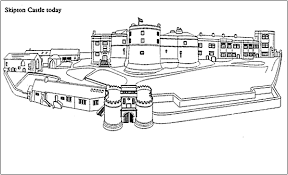Skipton Castle, the traditional seat of the Clifford family,
is a well preserved medieval castle that withstood three years of
siege by the Cromwellian forces during the English Civil War.
It was the last Royalist stronghold in the north of England holding
out for Charles I until, in December of 1645, an agreement of
surrender was reached and the royalist troops marched out of the
castle, not as prisoners but with full colors flying and trumpets
playing.
 The castle dates from 1090 but significant strengthening was done
to the castle in 1310 by Robert, the first Clifford Lord of
Skipton.It was this reinforcement that allowed the castle to
withstand three years of siege and bombardment.
The castle dates from 1090 but significant strengthening was done
to the castle in 1310 by Robert, the first Clifford Lord of
Skipton.It was this reinforcement that allowed the castle to
withstand three years of siege and bombardment.
 After the Castle was taken by the Parliamentarians Cromwell
ordered the removal of the castle's flat and thick roofs so that
cannon could no longer be placed there to defend the castle or fire
on approaching troops. When the roof was later replaced using
oak timbers it was under the understanding that it would not be flat,
would be much weaker than the original and would be unable to bear
the weight of a cannon. Cannon bearing flat roofs were
summarily banned across the country as a result of how effective they
were at Skipton Castle during the siege.
After the Castle was taken by the Parliamentarians Cromwell
ordered the removal of the castle's flat and thick roofs so that
cannon could no longer be placed there to defend the castle or fire
on approaching troops. When the roof was later replaced using
oak timbers it was under the understanding that it would not be flat,
would be much weaker than the original and would be unable to bear
the weight of a cannon. Cannon bearing flat roofs were
summarily banned across the country as a result of how effective they
were at Skipton Castle during the siege.


The walls of the castle, originally 6 feet deep, were also reduced to 1/2 that depth by the Parliamentarians so that they would no longer be able to withstand bombardment as well as they had during the Civil War.
 It was Lady Anne Clifford, herself born at Skipton Castle in
January of 1590, who restored the castle after the Civil War. In
1650, when the threat of war had ended, large windows were put into
the castle's thinner and newly restored outer walls.
It was Lady Anne Clifford, herself born at Skipton Castle in
January of 1590, who restored the castle after the Civil War. In
1650, when the threat of war had ended, large windows were put into
the castle's thinner and newly restored outer walls.


The castle's Renaissance Grotto was created by Henry, Lord Clifford between 1626-1629 and is one of two that survive in England today, the other being at Woburn Abbey.


The dungeon of the castle secured prisoners behind bolted doors at both the top and the bottom of the stairs down. Although leg irons were used on some prisoners of special importance it appears the Cliffords were benevolent to their prisoners in that torture was not used upon them.


In the Conduit Court stand a famous yew tree planted by Lady Anne in 1659. It is now over 9 feet in girth and a rare sight to behold.


In 1680 the castle's original kitchen was replaced by "the new kitchen" which remained in use until the 1840's. I doubt the cooks of that time found it all that "new" by then.

The walls of the castle, originally 6 feet deep, were also reduced to 1/2 that depth by the Parliamentarians so that they would no longer be able to withstand bombardment as well as they had during the Civil War.
The castle's Renaissance Grotto was created by Henry, Lord Clifford between 1626-1629 and is one of two that survive in England today, the other being at Woburn Abbey.
The dungeon of the castle secured prisoners behind bolted doors at both the top and the bottom of the stairs down. Although leg irons were used on some prisoners of special importance it appears the Cliffords were benevolent to their prisoners in that torture was not used upon them.
In the Conduit Court stand a famous yew tree planted by Lady Anne in 1659. It is now over 9 feet in girth and a rare sight to behold.
In 1680 the castle's original kitchen was replaced by "the new kitchen" which remained in use until the 1840's. I doubt the cooks of that time found it all that "new" by then.
No comments:
Post a Comment